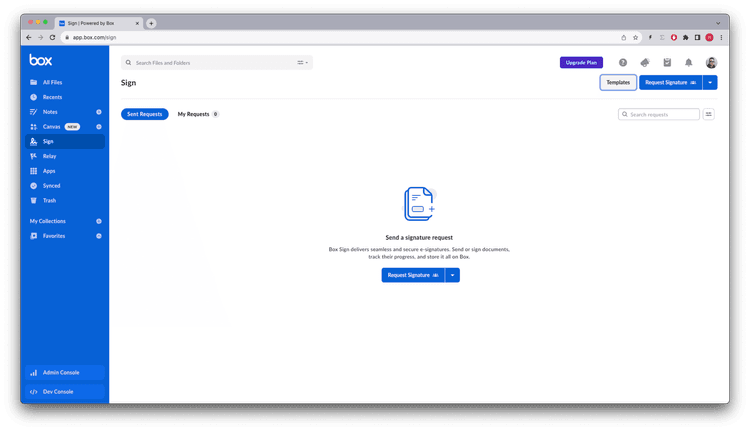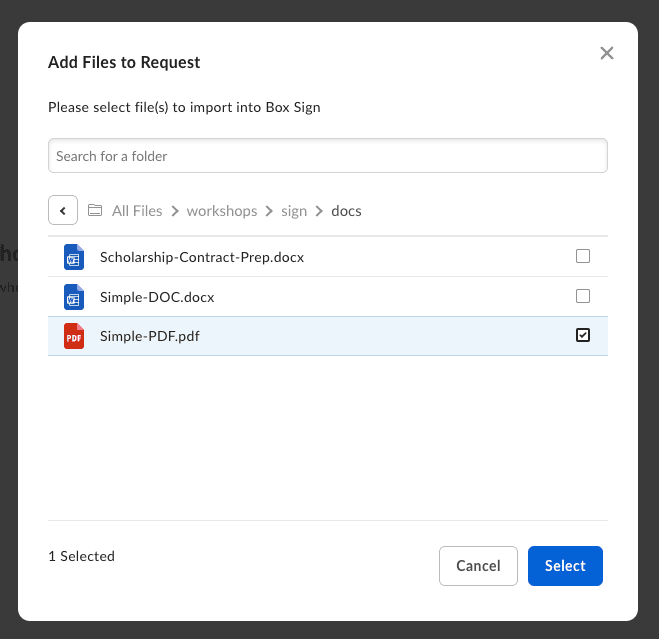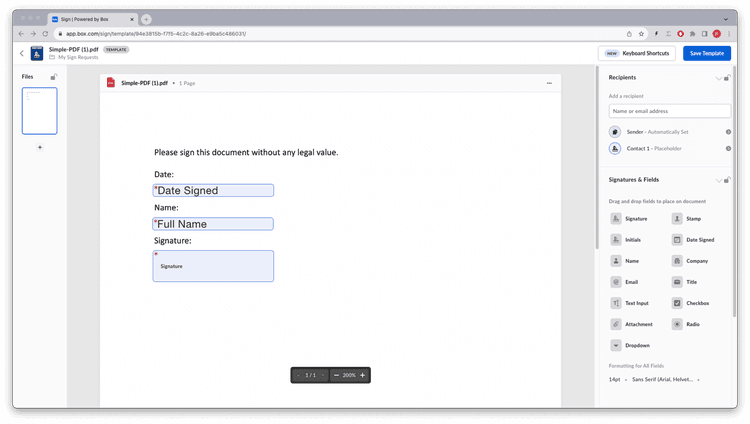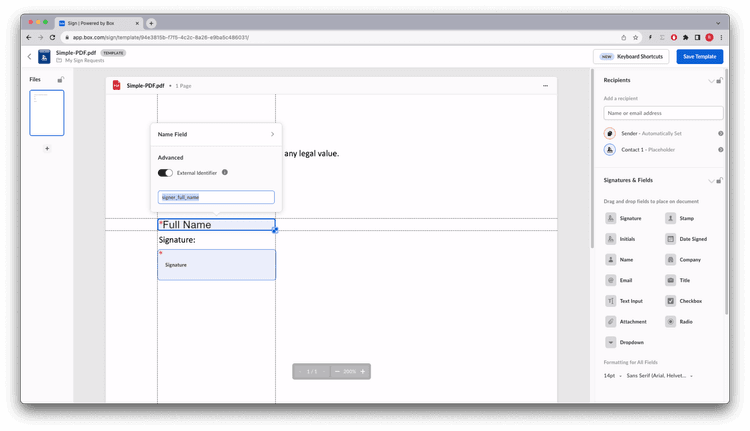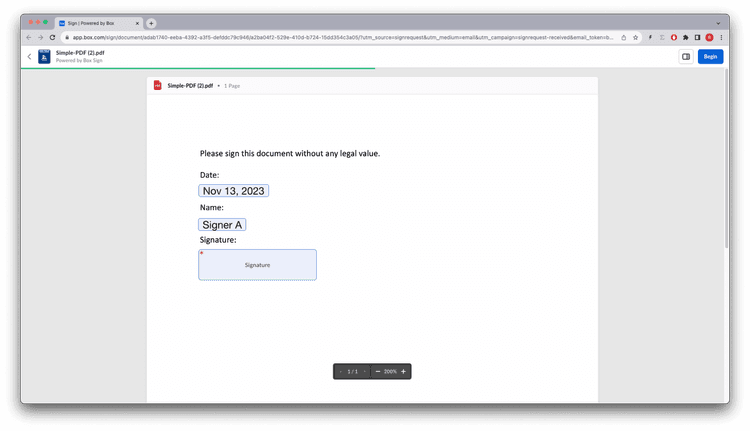Signing using templates
Signing using templates
A Box Sign template is a specific type of document that not only contains the text, but also the signature requirements and placement. It is prepared for signing in advance, and as such can be sent directly to the signer or signers.
Required fields include, for example, the signature pad field, the full name, and the date.
These fields have an owner, meaning they are populated by a specific signer and
cannot be shared between them. They can be mandatory or optional , and be
pre-populated by your application. However even if pre-populated, they can
always be changed by the signer.
Within the Box web app, the template not only sets the signature fields, but
also the number of signers, the order in which they sign, other roles and
recipients such as approver, and final_copy_recipient, email notification
settings, and a few more options.
For a complete set of options of the signature request please refer to the request options section.
These templates are exclusively created and managed in the Box Sign web app, and can be used to create signature requests using the API or the web app.
Let's start by creating a template.
Creating a template
From the Box app navigate to the sign menu on the left, then select templates.
Then, click on the New Template button, and choose or upload the document from Box.
For example, drag and drop a date, a name and a signature pad to the template, like so:
Save the template.
Identify the template
In order to work with templates in the Box Sign API we are going to need the
template_id . Consider this method to list all the templates available to the user:
curl --location 'https://api.box.com/2.0/sign_templates' \
--header 'Authorization: Bearer E9...Q0'
def sign_templates_list(client: Client):
"""List all sign templates"""
sign_templates = client.sign_templates.get_sign_templates()
print(f"\nSign templates: {len(sign_templates.entries)}")
for sign_template in sign_templates.entries:
print(f" {sign_template.id} - {sign_template.name}")
def main():
"""Simple script to demonstrate how to use the Box SDK"""
conf = ConfigOAuth()
client = get_client_oauth(conf)
user = client.users.get_user_me()
print(f"\nHello, I'm {user.name} ({user.login}) [{user.id}]")
sign_templates_list(client)
Returns something similar to (simplified):
{
"limit": 10,
"next_marker": null,
"prev_marker": null,
"entries": [
{
"type": "sign-template",
"id": "f2ec720d-47a6-4052-8210-9bfa8d6c349c",
"name": "Simple-DOC.pdf",
"parent_folder": {
"id": "157064745449",
"type": "folder",
"name": "My Sign Requests"
},
"source_files": [
{
"id": "1393013714313",
"type": "file",
}
],
"signers": [
{
"email": "",
"label": "",
"role": "final_copy_reader",
"inputs": []
},
{
"email": "",
"label": "Signer",
"role": "signer",
"inputs": [
{
"document_tag_id": null,
"id": "d02c8e16-5050-475e-b74b-9a952193e4f8",
"type": "date",
"date_value": null,
"content_type": "date",
},
{
"document_tag_id": null,
"id": "bdcc966e-2ebf-4b3b-aaee-99d4e1161a9e",
"type": "text",
"text_value": null,
"is_required": true,
"content_type": "full_name",
},
{
"document_tag_id": null,
"id": "1a8f4cb1-5c09-46bd-96f5-0ab449f19640",
"type": "signature",
"text_value": null,
"is_required": true,
"content_type": "signature",
}
]
}
],
}
]
}
Hello, I'm Rui Barbosa [18622116055]
Sign templates: 1
94e3815b-f7f5-4c2c-8a26-e9ba5c486031 - Simple-PDF.pdf
Creating a signature request from a template
The big advantage of using templates is that we do not need to worry about document preparation. Most of the signature options can be set in the template itself.
This is how the flow would look like:
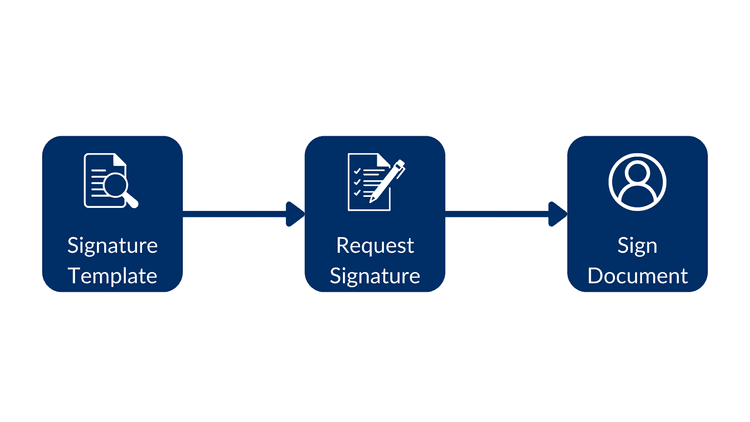
See this example:
curl --location 'https://api.box.com/2.0/sign_requests' \
--header 'Content-Type: application/json' \
--header 'Authorization: Bearer E9...Q0' \
--data-raw '{
"template_id": "f2ec720d-47a6-4052-8210-9bfa8d6c349c",
"parent_folder": {
"id": "234102987614",
"type": "folder"
},
"signers": [
{
"email": "signer@example.com",
"role": "signer"
}
]
}'
def create_sign_request(client: Client, template_id: str, signer_email: str):
"""Create sign request from template"""
parent_folder = FolderMini(
id=SIGN_DOCS_FOLDER, type=FolderBaseTypeField.FOLDER
)
signer = SignRequestCreateSigner(
email=signer_email,
)
sign_request = client.sign_requests.create_sign_request(
signers=[signer],
parent_folder=parent_folder,
template_id=template_id,
)
return sign_request
def main():
...
# Create sign request from template
sign_request = create_sign_request(client, TEMPLATE_SIMPLE, SIGNER_A)
check_sign_request(sign_request)
Resulting in (simplified):
{
"signers": [
{
"email": "sender@example.com",
"role": "final_copy_reader",
},
{
"email": "signer@example.com",
"role": "signer",
}
],
"id": "71e86670-5850-44cc-8b4d-9f5eab6c04de",
"parent_folder": {
"id": "234102987614",
"type": "folder",
"name": "signed docs"
},
"name": "Simple-DOC (1).pdf",
"type": "sign-request",
"status": "created",
"sign_files": {
"files": [
{
"id": "1393030489686",
"type": "file",
"name": "Simple-DOC (1).pdf",
}
],
},
"template_id": "f2ec720d-47a6-4052-8210-9bfa8d6c349c"
}
Simple sign request: b25674a2-540b-4201-ae18-a78f05ef1a9a
Status: created
Signers: 2
final_copy_reader: sender@example.com
signer: signer@example.com
Prepare url: None
The signer receives an email from Box.com with a link to the document, and can sign it.
Pre-populate the signature attributes
From a usability perspective, it is a good idea to pre-populate the inputs you require from your users.
Using the Box app sign template editor, you can assign an external_id to each
of the inputs, and have the app populate them from any data source.
Let’s implement this for the name.
Go back to the template design and add an id to the name field:
Save the template.
Let’s create a new method to pre-populate the name:
curl --location 'https://api.box.com/2.0/sign_requests' \
--header 'Content-Type: application/json' \
--header 'Authorization: Bearer E9..Q0' \
--data-raw '{
"template_id": "f2ec720d-47a6-4052-8210-9bfa8d6c349c",
"parent_folder": {
"id": "234102987614",
"type": "folder"
},
"signers": [
{
"email": "signer@example.com",
"role": "signer"
}
],
"prefill_tags": [
{
"document_tag_id": "signer_full_name",
"text_value": "Signer A"
}
]
}'
def create_sign_request_name_default(
client: Client, template_id: str, signer_name, signer_email: str
):
"""Create sign request from template"""
parent_folder = FolderMini(
id=SIGN_DOCS_FOLDER, type=FolderBaseTypeField.FOLDER
)
signer = SignRequestCreateSigner(
email=signer_email,
)
# tags
tag_full_name = SignRequestPrefillTag(
document_tag_id="signer_full_name",
text_value=signer_name,
)
sign_request = client.sign_requests.create_sign_request(
signers=[signer],
parent_folder=parent_folder,
prefill_tags=[tag_full_name],
template_id=template_id,
)
return sign_request
def main():
...
# Create sign request from template with name
sign_request_name = create_sign_request_name_default(
client, TEMPLATE_SIMPLE, "Signer A", SIGNER_A
)
check_sign_request(sign_request_name)
Resulting in (simplified):
{
"signers": [
{
"email": "sender@example.com",
"role": "final_copy_reader",
},
{
"email": "signer@example.com",
"role": "signer",
"is_in_person": false,
}
],
"id": "6f42a041-7ed8-4e08-9958-78a97259f80d",
"prefill_tags": [
{
"document_tag_id": "signer_full_name",
"text_value": "Signer A",
}
],
"parent_folder": {
"id": "234102987614",
"type": "folder",
"name": "signed docs"
},
"name": "Simple-DOC (2).pdf",
"type": "sign-request",
"status": "created",
"sign_files": {
"files": [
{
"id": "1393047116817",
"type": "file",
"name": "Simple-DOC (2).pdf",
}
],
},
"template_id": "f2ec720d-47a6-4052-8210-9bfa8d6c349c"
}
Simple sign request: adab1740-eeba-4392-a3f5-defddc79c946
Status: created
Signers: 2
final_copy_reader: sender@example.com
signer: signer@example.com
Prepare url: None
Open the signer inbox and complete the sign request.
When the signer views the document, the signer can still change it.
Get more information about a template
You've seen that you can list the templates available to a user. But you can also get more information about a specific template.
Let’s create a method that returns basic information of a template, but details all the signature requirements:
curl --location 'https://api.box.com/2.0/sign_templates/
f2ec720d-47a6-4052-8210-9bfa8d6c349c' \
--header 'Authorization: Bearer OL..BQ'
def sign_template_print_info(client: Client, template_id: str):
sign_template = client.sign_templates.get_sign_template_by_id(template_id)
print(f"\nSign template: {sign_template.id} - {sign_template.name}")
print(f" Signers: {len(sign_template.signers)}")
for signer in sign_template.signers:
print(f" {signer.role.value}")
if len(signer.inputs) > 0:
print(" Tag ID\t Type\t Required")
for input in signer.inputs:
print(
f" {input.document_tag_id} {input.type.value} {input.is_required}"
)
def main():
...
# Print sign template details
sign_template_print_info(client, TEMPLATE_SIMPLE)
Resulting in (simplified):
{
"type": "sign-template",
"id": "f2ec720d-47a6-4052-8210-9bfa8d6c349c",
"name": "Simple-DOC.pdf",
"parent_folder": {
"id": "234102987614",
"type": "folder",
"name": "signed docs"
},
"source_files": [
{
"id": "1393013714313",
"type": "file",
}
],
"signers": [
{
"email": "",
"label": "",
"role": "final_copy_reader",
},
{
"email": "",
"label": "Signer",
"role": "signer",
"inputs": [
{
"document_tag_id": null,
"id": "d02c8e16-5050-475e-b74b-9a952193e4f8",
"type": "date",
"is_required": true,
"date_value": null,
"content_type": "date",
},
{
"document_tag_id": "signer_full_name",
"id": "bdcc966e-2ebf-4b3b-aaee-99d4e1161a9e",
"type": "text",
"text_value": null,
"is_required": true,
"content_type": "full_name",
},
{
"document_tag_id": null,
"id": "1a8f4cb1-5c09-46bd-96f5-0ab449f19640",
"type": "signature",
"is_required": true,
"content_type": "signature",
}
]
}
],
}
Sign template: 94e3815b-f7f5-4c2c-8a26-e9ba5c486031 - Simple-PDF.pdf
Signers: 2
final_copy_reader
signer
Tag ID Type Required
None date True
signer_full_name text True
None signature True
Summary
Templates are a form of signing structured documents where the signature requirements are already defined and placed on the document.
This not only keeps your contract management team happy, but it also creates a process which is consistent and requires a low level of effort from your users.
Finally if your document signature requirements have a lot of options, you can pre-populate these from another data source and save the user some time. Remember that the user who owns these properties can always change them.
There is no API entry point to create a template, so you will have to create and manage them manually from the Box app, unless the document already includes signature tags that can be used by the Box Sign engine. Take a look at our Structured Docs section for more information.
